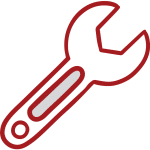
Products for Safety
Make sure a Certified Chimney Sweep like Quality Fireplace & Chimney Services inspects your solid fuel venting system annually and cleans and repairs it whenever needed. We have a variety of maintenance recommendations depending on how you use your fireplace or stove.
Why Do You Need Chimney Caps?
Chimney caps keep out the rain, right? If this were the only reason for installing a cap, it would be enough. I have seldom seen an uncapped chimney over five years old that was not suffering from some kind of water damage. Go over to your fireplace right now and look at the back firewall near the base. Take a screwdriver or coin and run it across the mortar between the bricks.
If it starts to crumble, you have a problem. When rain puddles on the smoke shelf, it mixes with creosote in the chimney to become a highly corrosive acid. This will seep down and attack the mortar joints on the back wall of the fireplace. The mortar becomes weak, and—presto—the bricks on the wall become loose.
Other reasons it’s important to keep rain out:
- Rain can set off a bad smell in the chimney. This will happen in warm weather, especially if the chimney is dirty or has animal droppings on the smoke shelf.
- Rain speeds the rusting of metal parts of your fireplace. Is the damper hard to move or is it frozen? This is a good indication rain is damaging the interior of the chimney parts.
Importance of a Chimney Top Damper
Huge heat loss occurs when a chimney damper doesn’t seal properly or is missing or broken. You can’t see it; the heat just goes out of the house. If your chimney’s damper isn’t sealing properly, it’s like leaving the front door open in the middle of winter!
A simple, cost effective solution is having Quality Fireplace install a Top Sealing Damper Cap. The stainless steel cap-damper has a special 7 x 7 strand stainless steel aircraft cable which runs inside the flue. It is simple to operate with a handle right in your living room.
Chimney Waterproofing
There are approximately 40 million masonry chimneys in North America, and the most common problem with these structures is water penetration.
Water causes over 1 billion dollars in damage annually in the form of staining, loss of insulation value, freeze-thaw damage, deterioration, and ultimately structural failure. All new and existing masonry chimneys are susceptible to water damage, and, even if repaired, chimneys will continue to deteriorate if they are not protected.
ChimneySaver, which comes with a 10 year warranty, is the first water repellent specifically developed to protect chimneys from the severe weather conditions to which they are exposed.
ChimneySaver is a water repellent not a water sealer. The difference could save you hundreds or even thousands of dollars in repairs because sealers can actually damage masonry. Unlike waterproofing sealers that remain on the surface and trap water vapors, ChimneySaver penetrates deep enough to protect masonry from destructive water penetration.
Water Damage Can Be Prevented
Chimneys are highly exposed to the elements and—if left unprotected—are susceptible to structural deterioration. It is important to address this problem before serious damage occurs.
ChimneySaver contains patented siloxanes small enough to penetrate most masonry pores up to 114″ or more. These special siloxanes form strong bonds with the silica in masonry and concrete. Because of this bonding process, one application of ChimneySaver provides up to ten times the water repellent protection of typical sealers.
100% Breathable
Moisture from a variety of sources is always present in masonry and concrete. Sealers and silicone coatings form a water resistant surface film which traps water vapors. If these vapors cannot escape, they will contribute to spalling, scaling, deterioration, and freeze-thaw damage.
It is 100% vapor permeable—a non-film-forming water repellent that penetrates and lines masonry pores. ChimneySaver offers the best protection because it releases water vapors and effectively reduces water absorption. ChimneySaver is an investment in long-term protection that will help prevent expensive reconstruction.
No water repellent, however, is a substitute for good construction and workmanship. The first step in preventing water damage is to make necessary repairs to structural cracks, damaged crowns, lashings, deteriorated bricks, and mortar joints. The second step is to protect porous masonry from further water penetration by applying ChimneySaver water repellent.
Talk to Quality Fireplace about applying ChimneySaver to your chimney or other masonry surfaces.
Why is a Chimney Liner Necessary?
Gas-fired heating appliances produce low temperature, high moisture content flue gas which collects as acidic condensate on the inside of oversized, cold masonry chimneys. It is this condensate that is the primary cause of masonry chimney deterioration, which creates a serious health hazard as well as costly home repairs.
Liners Help Prevent Chimney Deterioration
Installing a lightweight, properly sized metal chimney liner will help create efficient, condensate-free venting. Insulating the liner is recommended and will further enhance operation of the venting system.
Chimney Liner Material
Aluminum, with a half-century usage history, has proven to be an economical, effective material for venting gas-fired equipment. Stainless steel is a good choice as well and offers a lifetime warranty, although it is substantially more expensive.
Why Should Quality Fireplace Install/Maintain Your Liner
A qualified heating or chimney contractor is the best person to install this type of product. There are several technical details which must be addressed before a liner is installed. A gas liner should be checked at least once a year by a qualified technician to ensure that the system is venting properly without condensation occurring.
About Crown Replacements
Customers often ask what the purpose of a chimney crown is. It’s important to note that a crown is not a chimney cap; the crown plays a vital role allowing water to shed off the top chimney chase and caps off the brickwork of the chimney.
In Wisconsin, the most frequent type of crown damage we see is freeze-thaw damage due to extreme temperatures and high exposure. Freeze-thaw damage occurs when your chimney is saturated with cold rain followed by a drop in temperature below freezing. Ongoing freeze-thaw cycles cause cracks and premature brick spalling, a type of failure caused by moisture in which brick faces actually start to pop off. You may see them lying around the ground or on your roof.
Sometimes the chimney crown can simply use some resurfacing; other times the crown needs to be removed and replaced with the correct materials and proper practices. In severe cases where the chimney not only has crown damage, but also damage to the bricks on the top of the chimney, the top portion of the chimney may need rebuilding.
Whatever crown situation you find yourself in, you can rely on our expertise to repair or replace them so you can get the most out of your fireplace.
Serious Dangers
While your chimney may look just fine on the outside, it could be hiding serious dangers on the inside. A thorough inspection of your chimney liner may reveal hidden dangers, hazards, and draft problems caused by gaps, cracks, and spalling in otherwise sound masonry chimneys.
If you have a damaged chimney liner, HeatShield® can restore your chimney’s clay flue liner and save you the expense of rebuilding or relining with a stainless steel chimney liner. HeatShield® is a specially formulated Cerfractory® sealant material that restores the integrity of your chimney flue to vent hazardous gases from your home. It also eliminates the dangers in your chimney caused by gaps, cracks, and spalling for years to come. This is an “eco-friendly” product made from recycled and naturally occurring materials that offers you a less costly alternative to rebuilding your chimney or the destructive removal of flue tiles before the chimney can be relined.
Call Quality Fireplace & Chimney today to ask about our professional HeatShield® installers and the innovative HeatShield® system.
Learn About Creosote
Certain types of creosote cannot be removed with standard chimney cleaning methods, such as the glass-like coating of creosote, often referred to as glazed or 3rd degree creosote. There is only one method of removing glazed creosote that is both effective and harmless to your chimney interior—PCR.
A poultice is a centuries-old technique of applying an absorbent substance to a layer of toxins. When PCR is applied, it dissolves the creosote and absorbs it as it dries. The dried, creosote-infused PCR will lose its adhesion and fall from the flue walls. Any remaining PCR can easily be removed with a chimney sweep.
- Completely removes 3rd degree glazed creosote
- Eliminates the need for potentially destructive cleaning methods
- Performs quickly and efficiently
Call Quality Fireplace today to learn more about ridding your chimney of creosote with PCR.
Gas Fireplace Inserts
Made to fit up to 95% of existing wood fireplaces, Regency Gas Fireplace Inserts are the most efficient way to fix cold chimney draft, lower your home heating bill, and update the look of a room.
Available in contemporary and traditional designs, gas fireplace inserts transform old wood fireplaces into high-efficiency gas heaters using either natural gas or propane. Regency inserts are designed to be placed inside an existing masonry fireplace and use the existing fireplace and chimney to hold the unit and support venting.
Protection Against Water Damage
A chase cover is a metal covering on top of a prefabricated or factory-built chimney (if you have a masonry chimney you most likely have a crown, or concrete slab, at the top). The chase cover and chimney cap help keep the elements—including water, snow, leaves, debris, and critters—out of the fireplace and flue. But they can only offer proper protection against water damage if they’re properly sized and designed and free of damage themselves.
Quality Fireplace only uses stainless steel that is measured and custom fabricated to the specifications of each customer’s fireplace. We guarantee that our chase covers won’t leak with a lifetime warranty against rust, corrosion, and manufacturer defects. Install a stainless steel chase cover as a lifetime fix, and add extra features like diagonal creases and drip edges at no additional cost!
If you have a chase cover, make sure it’s made of quality metal and perfectly fitted to your chimney. It should be inspected annually and replaced when rust or other damage appears.

Don’t Wait, Be Safe
Regular cleanings and repairs help reduce the chance of chimney fires. Don’t wait—be safe and schedule an appointment with us today.

Chimney Sweep
Our service is unique in that we don’t just do a sweep; we go up top to inspect the bricks, crown, flue tiles, flashing, mortar, caps, etc.

Chimney Repair
A properly maintained chimney should neither leak nor block the regular flow of smoke, soot or air through the flue.
